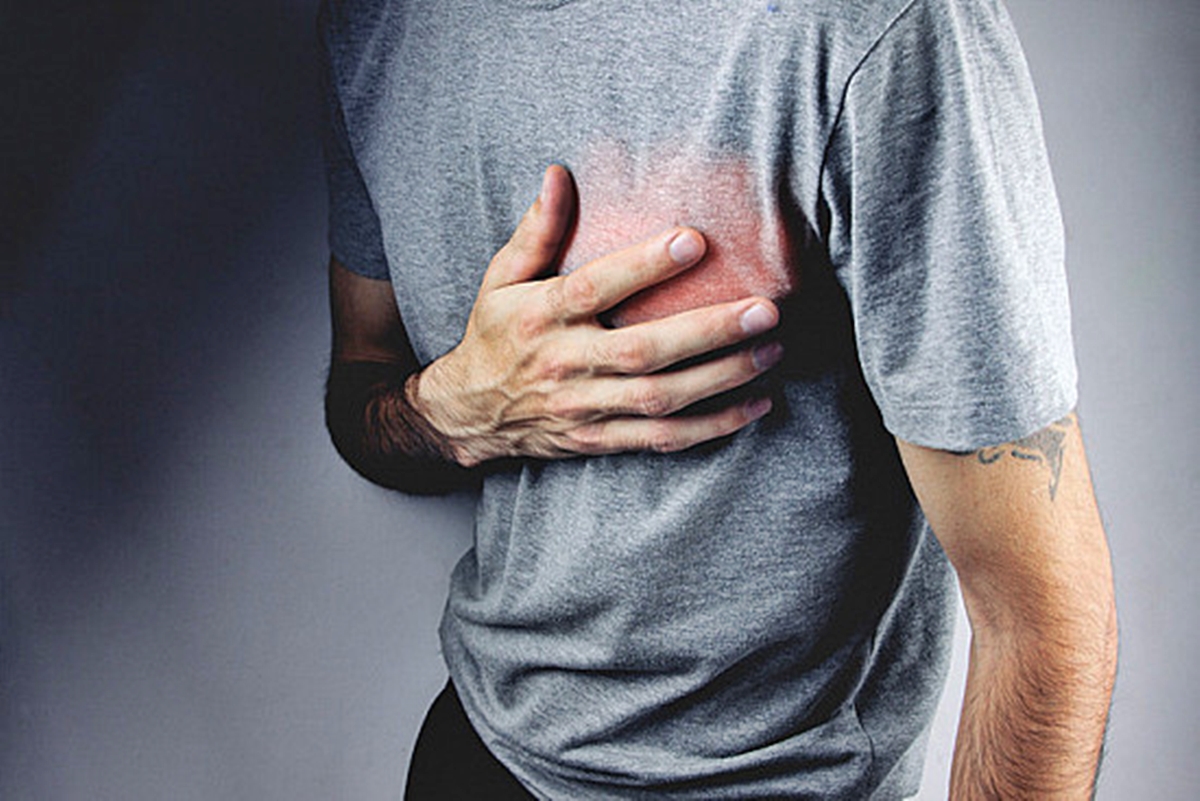Home>Misc>Featured>What Body Changes In Adolescence Increase Physical Endurance?


Featured
What Body Changes In Adolescence Increase Physical Endurance?
Modified: October 24, 2023
Discover the body changes in adolescence that boost physical endurance, including a featured element. Learn more about these transformative changes and their impact.
Introduction
Adolescence is a phase of life that marks a significant transition from childhood to adulthood. It is a time when individuals experience a myriad of physical, emotional, and cognitive changes. One of the notable aspects of adolescence is the physical transformation that occurs as a result of puberty.
Puberty is a natural process that initiates the development of sexual characteristics and the maturation of the reproductive system. It is during this period that the body undergoes numerous changes, both internally and externally, which play a crucial role in shaping an individual’s physical endurance.
In this article, we will delve deeper into the body changes in adolescence that contribute to the overall increase in physical endurance. From hormonal shifts to the development of muscles and cardiovascular improvements, we will explore the various factors that lead to enhanced stamina and endurance during this transformative phase of life.
Understanding these changes is not only essential for adolescents themselves but also for parents, educators, and healthcare professionals who play a vital role in supporting and guiding adolescents through this critical stage. By shedding light on the physical transformations that occur during adolescence, we can better comprehend how to harness and optimize the increased endurance and physical capabilities that come with it.
Puberty and Adolescence
Puberty is a natural and complex process that marks the beginning of adolescence. It typically occurs between the ages of 8 and 14 in girls and between 9 and 16 in boys. During this phase, the body undergoes significant changes as it prepares for reproductive maturity.
Adolescence, on the other hand, is a broader term that encompasses the entire period of transition from childhood to adulthood. It is a time of rapid physical growth, emotional development, and social changes.
Puberty is triggered by hormonal signals from the brain, particularly the hypothalamus and the pituitary gland. These hormones, known as gonadotropin-releasing hormone (GnRH), follicle-stimulating hormone (FSH), and luteinizing hormone (LH), stimulate the development of the reproductive organs and the production of sex hormones such as estrogen and progesterone in females and testosterone in males.
As the body goes through puberty, it experiences various physical changes, including height increase, development of secondary sexual characteristics, and the onset of the menstrual cycle in females and the growth of facial hair and deepening of the voice in males.
These changes are not only limited to the external appearance but also involve internal organs and systems. One noticeable aspect of adolescence is the increase in physical endurance, which is facilitated by several physiological alterations in the body.
Understanding the relationship between puberty, adolescence, and physical endurance is crucial in comprehending the remarkable abilities and challenges that individuals in this phase of life experience. By recognizing and harnessing these changes, adolescents can optimize their physical performance and overall well-being.
Physical Changes in Adolescence
Adolescence is a time of immense physical transformation. The body undergoes numerous changes that are not only visible on the outside but also impact the internal systems and organs. These physical changes are vital in understanding the increase in physical endurance during this phase of life.
One of the most eminent physical changes in adolescence is the growth spurt. During this period, individuals experience a rapid increase in height as their bones grow longer and their bodies become more lean and muscular. This growth, fueled by the release of growth hormones, allows for the development of a stronger and more resilient physical frame.
In addition to height growth, there is also a profound reshaping of the body’s proportions. The hips widen in females, facilitating the potential for childbirth, while males develop broader shoulders and a more muscular physique, enhancing their physical strength.
Moreover, the development of secondary sexual characteristics plays a significant role in physical endurance. In females, the increase in estrogen levels leads to the development of breasts and the widening of the pelvic region. These changes not only contribute to the overall physical appearance but also support the body’s ability to handle the demands of physical activity.
In males, the rise in testosterone levels during adolescence leads to the growth of facial and body hair, deepening of the voice, and an increase in muscle mass. These changes contribute to the development of stronger and more powerful muscles, enhancing physical performance and endurance.
Another vital physical change in adolescence is the development of the skeletal and muscular systems. The bones become denser and stronger, while the muscles grow in size and strength. This development is crucial in supporting the body during physical activities, increasing stamina, and improving overall endurance.
Furthermore, the body composition changes during adolescence. The percentage of body fat decreases, while lean muscle mass increases. This shift in body composition not only enhances physical performance but also improves metabolic efficiency, allowing for greater endurance and stamina.
Overall, the physical changes that take place during adolescence contribute to the remarkable increase in physical endurance. From the growth spurt and the development of secondary sexual characteristics to the strengthening of the skeletal and muscular systems, these changes enable adolescents to engage in physical activities with greater stamina and resilience.
Hormonal Changes
Hormones play a pivotal role in guiding the physical changes during adolescence. These chemical messengers are responsible for coordinating and regulating various bodily functions, including growth and development.
During puberty, the hypothalamus and pituitary gland signal the release of hormones that stimulate the development of reproductive organs and secondary sexual characteristics. In females, the ovaries produce estrogen and progesterone, while in males, the testes produce testosterone.
These sex hormones not only contribute to sexual development but also have a significant impact on physical endurance.
Estrogen, the primary female sex hormone, promotes the growth and development of reproductive organs, such as the uterus and breasts. It also influences the deposition of fat, particularly in the buttocks and thighs. Estrogen levels rise significantly during adolescence, contributing to the growth spurt and the development of secondary sexual characteristics.
In addition to its role in sexual development, estrogen has important effects on the cardiovascular system. It helps to relax the blood vessels, improving blood flow to the muscles during physical activity. This increased blood flow delivers oxygen and nutrients more efficiently to the working muscles, allowing for better endurance and performance.
Testosterone, the male sex hormone, is responsible for the development of male secondary sexual characteristics, such as facial hair, muscle mass, and a deeper voice. It also plays a crucial role in building and strengthening muscle tissue.
During adolescence, testosterone levels rise in males, leading to an increase in muscle mass and bone density. This increase in muscle mass contributes to improved physical endurance by providing more strength and power for physical activities.
In both males and females, hormonal changes also affect metabolism. As estrogen and testosterone levels increase, the metabolic rate elevates, leading to more efficient energy utilization and improved endurance.
Furthermore, hormones influence mood, motivation, and overall mental well-being. Adolescence is a time of emotional changes, and hormonal fluctuations can impact these aspects of an individual’s life. By regulating emotions and promoting a sense of motivation, hormones indirectly contribute to improved physical endurance.
Overall, the hormonal changes that occur during adolescence have a profound impact on physical endurance. Estrogen and testosterone, along with their effects on the cardiovascular system, metabolism, and muscle development, play a crucial role in improving endurance and stamina during this transformative phase of life.
Development of Muscles
One of the major physical changes that occur during adolescence is the development of muscles. As individuals go through puberty, their bodies experience an increase in muscle size, strength, and density, which significantly contributes to their physical endurance.
During adolescence, hormonal changes, particularly the rise in testosterone in males and estrogen in females, play a crucial role in muscle development. Testosterone promotes protein synthesis, which leads to an increase in muscle mass and strength. It stimulates the growth of new muscle fibers and enhances the conversion of storage glycogen into usable energy, improving endurance.
In females, estrogen also contributes to muscle development. While females may not experience the same level of muscle growth as males due to lower testosterone levels, estrogen still aids in increasing muscle mass and strength to some extent.
Beyond hormone influences, the development of muscles in adolescence is also influenced by physical activity. Regular exercise and strength training during this period can further enhance muscle growth and endurance. Engaging in activities like weightlifting, resistance training, and sports participation can help promote the development of lean muscle tissue and improve overall physiological function.
As muscles grow and strengthen, they become more efficient at utilizing oxygen and nutrients, which reduces fatigue and improves endurance. Moreover, increased muscle mass leads to an increase in resting metabolic rate, allowing individuals to burn calories more efficiently and maintain a healthy weight.
In addition to the physical benefits, the development of muscles during adolescence also has positive implications for mental well-being. Regular exercise and strength training have been shown to improve mood, reduce stress, and increase self-confidence, all of which can have a direct impact on an individual’s physical endurance and overall performance.
It is important to note that while muscle development is a natural part of adolescence, it is essential to engage in safe and appropriate physical activity. Consulting with professionals, such as trainers or coaches, can help individuals design exercise programs that are suitable for their age and physical capabilities.
Overall, the development of muscles during adolescence is a critical component of increased physical endurance. Hormonal influences, particularly testosterone in males and estrogen in females, along with regular exercise and strength training, contribute to the growth and strengthening of muscles. This enhanced muscle mass and strength result in improved oxygen utilization, greater endurance, and ultimately, better physical performance.
Increase in Lung Capacity
Another significant physical change that occurs during adolescence is the increase in lung capacity. The respiratory system undergoes important developments that have a direct impact on an individual’s physical endurance.
During puberty, the ribcage expands, the chest cavity enlarges, and the lung tissue grows. These changes allow for increased lung capacity, which refers to the maximum amount of air that can be inhaled and exhaled during a breath.
One of the key factors contributing to the increase in lung capacity is the growth of the alveoli. Alveoli are tiny air sacs in the lungs where oxygen is exchanged with carbon dioxide. As adolescents go through puberty, the number and size of alveoli increase, providing a larger surface area for gas exchange.
In addition to the structural changes, hormonal influences also play a role in the development of the respiratory system. Estrogen, in particular, has been found to enhance lung function by improving the elasticity of lung tissues and enhancing the efficiency of oxygen uptake.
The increase in lung capacity leads to several benefits in terms of physical endurance. It allows for a higher volume of oxygen intake during physical activities, delivering more oxygen to the working muscles. This increased oxygen supply is crucial for energy production and muscle performance, contributing to improved stamina and endurance.
Moreover, the larger lung capacity enables individuals to expel carbon dioxide more efficiently, preventing the build-up of waste products in the body. This efficient removal of carbon dioxide helps maintain better acid-base balance and contributes to overall enhanced physical performance.
Regular aerobic exercise, such as running, swimming, or cycling, during adolescence can further improve lung capacity. These activities require sustained effort and deep breathing, which helps strengthen the respiratory muscles and improve lung function.
It is important to note that smoking and exposure to second-hand smoke can have detrimental effects on lung capacity and function. Adolescents should be educated about the harmful effects of smoking and encouraged to avoid smoking or being in environments where they are exposed to smoke.
Overall, the increase in lung capacity during adolescence plays a vital role in improving physical endurance. The expansion of the chest cavity, growth of alveoli, and hormonal influences contribute to better oxygen uptake and efficient removal of waste products. These adaptations enable individuals to engage in physical activities with greater endurance, stamina, and overall performance.
Cardiovascular Changes
Adolescence is a crucial period for cardiovascular system development. The heart and blood vessels undergo significant changes that contribute to improved physical endurance and stamina.
One of the notable cardiovascular changes during adolescence is the enlargement of the heart. As individuals go through puberty, the heart muscles thicken and become stronger. This increased muscle mass allows the heart to pump blood more efficiently and deliver oxygen and nutrients to the body’s tissues and organs.
In addition to the structural changes in the heart, the cardiovascular system undergoes adaptive changes to support increased physical activity. The blood volume increases, enabling a greater oxygen-carrying capacity. This ensures that an adequate supply of oxygen is available to the working muscles during physical exertion, enhancing endurance.
The blood vessels also play a crucial role in cardiovascular changes during adolescence. The arteries become more elastic and adaptive, allowing for improved blood flow and distribution throughout the body. This increased elasticity reduces the workload on the heart and enhances cardiovascular efficiency.
Furthermore, the development of collateral blood vessels occurs during adolescence. Collateral vessels are small, secondary blood vessels that form when there is increased demand for blood flow to specific tissues or muscles. This increased network of blood vessels ensures that there is a sufficient blood supply to the working muscles, even during intense physical activity.
Another crucial aspect of cardiovascular changes in adolescence is the reduction in resting heart rate. As individuals grow older, their resting heart rate decreases due to an increase in stroke volume, which is the amount of blood pumped with each heartbeat. A lower resting heart rate is an indicator of an efficient cardiovascular system, allowing the heart to pump blood more effectively during physical activities and reducing overall strain on the heart.
The combination of these cardiovascular changes during adolescence leads to several benefits in terms of physical endurance. The heart’s ability to pump more blood with each beat and the improved oxygen-carrying capacity of the blood result in enhanced endurance and stamina.
In order to optimize the cardiovascular system’s development during adolescence, it is crucial to engage in regular aerobic exercise. Activities such as running, cycling, swimming, and dancing are excellent choices as they promote cardiovascular health and increase endurance.
It is essential to note that maintaining a healthy lifestyle, including a balanced diet, adequate hydration, and sufficient rest, is crucial for promoting optimal cardiovascular development and overall well-being during adolescence.
Overall, the cardiovascular changes that occur during adolescence, such as heart enlargement, increased blood volume, improved arterial elasticity, and the development of collateral blood vessels, contribute to enhanced physical endurance and stamina. Understanding these changes and engaging in regular aerobic exercise can help adolescents maximize their cardiovascular potential and achieve peak physical performance.
Increase in Red Blood Cells
Another significant physical change that occurs during adolescence is the increase in red blood cells (RBCs). Red blood cells are responsible for carrying oxygen from the lungs to the body’s tissues and organs. The rise in RBC count plays a crucial role in enhancing physical endurance and stamina.
During puberty, hormonal changes, particularly the increase in testosterone and estrogen, stimulate the production of RBCs in the bone marrow. As a result, there is an increase in the total number of RBCs in the bloodstream.
The increase in RBC count leads to greater oxygen-carrying capacity in the blood. This means that more oxygen can be transported to the muscles and organs during physical activity, improving endurance and performance.
The higher number of RBCs also enhances the body’s ability to remove waste products, such as carbon dioxide, more efficiently. As a result, fatigue is reduced, and individuals can engage in physical activities for more extended periods without experiencing excessive tiredness.
Additionally, the increase in RBC count also benefits aerobic capacity. Aerobic capacity refers to the body’s ability to take in, transport, and utilize oxygen during exercise. With more RBCs available to carry oxygen, the aerobic capacity increases, allowing individuals to sustain physical activity for longer durations.
Regular aerobic exercise, such as running or cycling, during adolescence can further stimulate the production of RBCs and improve their function. Exercise promotes blood flow and oxygen delivery to the bone marrow, supporting the production of new RBCs.
It is worth noting that proper nutrition is essential for optimal RBC production and function. Iron, vitamin B12, and folate are vital nutrients needed for the production of healthy RBCs. Including a balanced diet rich in foods such as lean meats, leafy green vegetables, and fortified cereals can help ensure an adequate supply of these nutrients.
Furthermore, adequate hydration is essential for maintaining optimal blood volume and RBC function. Staying hydrated helps prevent the thickening of the blood, ensuring that RBCs can flow smoothly through the blood vessels and deliver oxygen efficiently.
Overall, the increase in RBC count during adolescence is a significant contributor to improved physical endurance. The higher number of RBCs enhances oxygen transport, reduces fatigue, and improves aerobic capacity. By engaging in regular aerobic exercise and maintaining a healthy diet and hydration, adolescents can maximize their RBC production and enhance their physical performance.
Improved Stamina and Endurance
Through the various physical changes discussed earlier, adolescence brings about a remarkable improvement in stamina and endurance. The culmination of hormonal shifts, muscular development, increased lung capacity, cardiovascular changes, and the rise in red blood cells all contribute to enhancing an individual’s physical performance.
As adolescents experience growth spurts and their bodies develop, they gain a higher level of physical strength and power. The increase in muscle mass and bone density, stimulated by hormones such as testosterone and estrogen, allows for greater physical resilience and improved stamina.
The development of the respiratory system, including an increase in lung capacity and efficiency, enables individuals to take in more oxygen during physical activity. This enhanced oxygen uptake leads to better energy production, reduced fatigue, and increased stamina.
Cardiovascular changes, such as heart enlargement, increased blood volume, and improved arterial elasticity, allow for more efficient blood circulation and delivery of oxygen to the working muscles. These adaptations promote endurance and prevent the onset of fatigue during prolonged physical exertion.
The increased number of red blood cells in the bloodstream further enhances endurance. With a higher RBC count, more oxygen can be transported to the muscles, enabling individuals to sustain physical activity for longer periods and delay the onset of fatigue.
Moreover, the combination of physical changes in adolescence not only contributes to improved physical endurance but also positively impacts overall mental well-being. Regular exercise, strength training, and participation in physical activities lead to the release of endorphins, promoting a sense of well-being, reducing stress, and enhancing motivation which can further enhance stamina and endurance.
Building stamina and endurance during adolescence is not merely about the physical changes alone but also about maintaining a healthy lifestyle. Adequate nutrition, hydration, sufficient rest, and regular exercise all play vital roles in optimizing physical performance and allowing individuals to reach their full endurance potential.
It is important to note that every individual’s journey of building stamina and endurance in adolescence is unique. The rate of development and the extent of physical changes can vary from person to person. It is crucial to respect one’s own body, listen to its limits, and gradually increase physical activity to avoid injury and promote long-term endurance.
Overall, the combination of hormonal shifts, muscular development, increased lung capacity, cardiovascular changes, and the rise in red blood cells converge to create a significant improvement in stamina and endurance during adolescence. Through proper nutrition, hydration, rest, and regular exercise, individuals can optimize these physical changes and enjoy the benefits of improved physical performance and resilience.
Conclusion
Adolescence is a transformative phase of life marked by numerous physical changes that significantly impact an individual’s physical endurance. From the onset of puberty to the development of secondary sexual characteristics, hormonal shifts play a critical role in shaping physical capabilities.
The development of muscles, increased lung capacity, cardiovascular changes, and the rise in red blood cells all contribute to the remarkable improvement in stamina and endurance during this period. These physiological adaptations enable adolescents to engage in physical activities with greater strength, endurance, and overall performance.
Understanding and embracing these physical changes play a vital role in supporting adolescents as they navigate through this transformative phase. Educators, parents, and healthcare professionals can provide guidance and support to help adolescents optimize their physical potential and promote a healthy lifestyle.
Furthermore, engaging in regular aerobic exercise, strength training, and sports participation can further enhance physical endurance during adolescence. It is important to emphasize the importance of proper nutrition, hydration, rest, and gradual progression to maintain the benefits of physical changes and minimize the risk of injury.
As adolescents build stamina and endurance, they also reap the benefits of improved mental well-being and enhanced overall wellness. Physical activity has been linked to reduced stress, improved mood, and increased self-confidence. These psychological benefits further motivate adolescents to maintain an active and healthy lifestyle.
In conclusion, adolescence brings about significant physical changes that increase physical endurance. From hormonal shifts to the development of muscles, cardiovascular improvements, increased lung capacity, and the rise in red blood cells, these changes work in harmony to enhance stamina and endurance. By understanding and embracing these physical transformations, adolescents can optimize their physical potential, promote a healthy lifestyle, and enjoy the benefits of improved physical performance and overall well-being during this critical phase of life.









